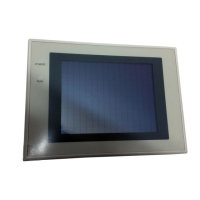601
Examples of Actual Applications of Direct Access
Section 10-1
10-1 Examples of Actual Applications of Direct Access
Some examples that will give you an idea of how to actually apply the functions of
the NT31/NT31C such as those indicated below are presented here.
S Continually monitoring a specific PC bit and displaying an alarm when it comes
ON ...... page 601
S Changing display contents in accordance with PC bit status ..... page 606
S Displaying online help with a touch switch ..... page 609
S Continually monitoring a specific PC bit and displaying a message on a window
when it comes ON ..... page 610
S Continuously reading out the contents of a PC word and displaying a thend
graph by backtracking ..... page 612
S Displaying the day of the week using the clock data in the PT ..... page 613
In these examples, only the necessary settings are shown. Make the unspecified
settings according to your requirements. In some of the examples, colors other
than black and white are used for the display colors; note that these examples can
be applied even with monochrome type PTs, for example by setting the display of
black and white in reverse video.
For the method for creating screens with the Support Tool, refer to the NT-Series
Support Tool Ver. 3.0E for Windows95/98 Operation Manual (V053-E1-j).
Continually Monitoring a Specific PC Bit and Displaying an Alarm When It Comes ON
Example: Displaying “TEMPERATURE ABNORMAL” in red, regardless of the screen cur-
rently displayed, when the monitored bit at the PC comes ON.
PC
1
NT31/NT31C
ON
TEMPERATURE
ABNORMAL
Bit
Alarm list
(1) Set “TEMPERATURE ABNORMAL” as the initial value for any character
string memory table.
(2) Make the following settings for any bit memory table.
- PC Address: PC bit number to be monitored
- Function: Alarm
- String table entry: Number of the character string memory table for
which settings were made in (1).

